A Report on Psychological Explanations of Violence and Aggression
VerifiedAdded on 2023/06/10
|8
|2599
|257
Report
AI Summary
This report delves into the psychological explanations of violence and aggression in young people, examining biological and behavioral theories. It discusses how factors like genetics, hormones, and environmental influences contribute to aggressive behavior. The report also differentiates between emotional and instrumental aggression, highlighting the role of social learning and cognitive processes in shaping violent tendencies. Ultimately, it emphasizes the complex interplay of psychological, biological, and social factors in understanding and addressing youth violence and aggression. This document is available on Desklib, a platform offering a wide range of study resources for students.
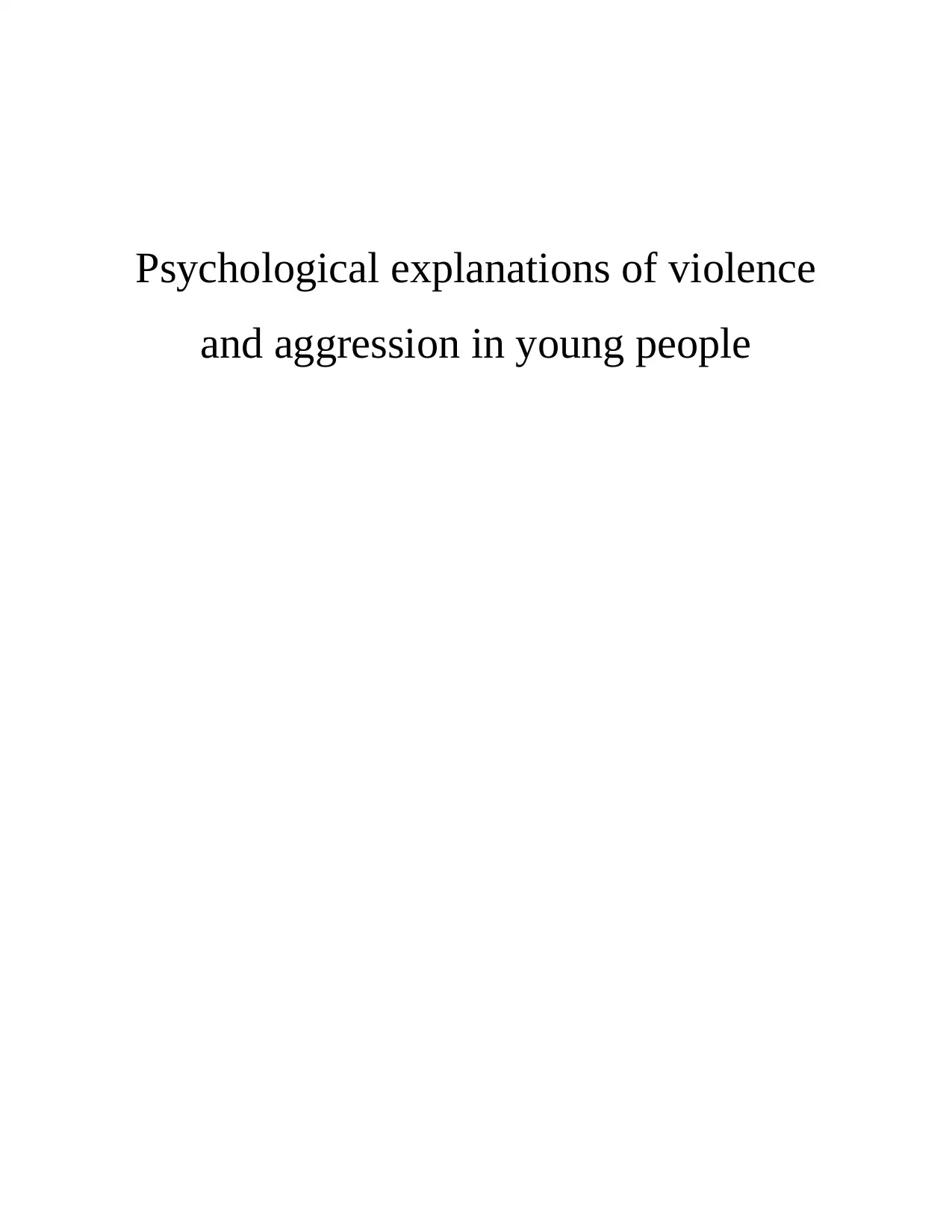
Psychological explanations of violence
and aggression in young people
and aggression in young people
Paraphrase This Document
Need a fresh take? Get an instant paraphrase of this document with our AI Paraphraser
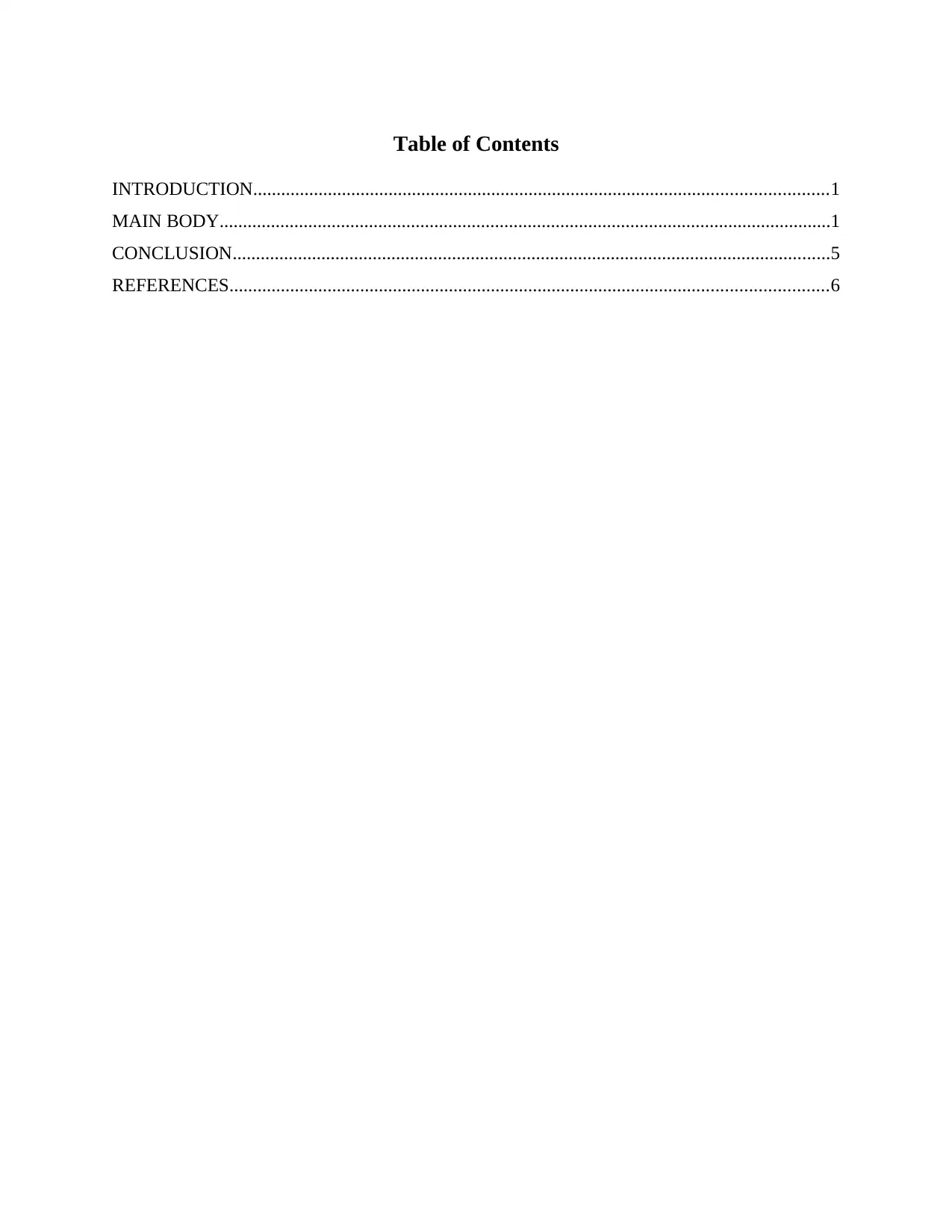
Table of Contents
INTRODUCTION...........................................................................................................................1
MAIN BODY...................................................................................................................................1
CONCLUSION................................................................................................................................5
REFERENCES................................................................................................................................6
INTRODUCTION...........................................................................................................................1
MAIN BODY...................................................................................................................................1
CONCLUSION................................................................................................................................5
REFERENCES................................................................................................................................6
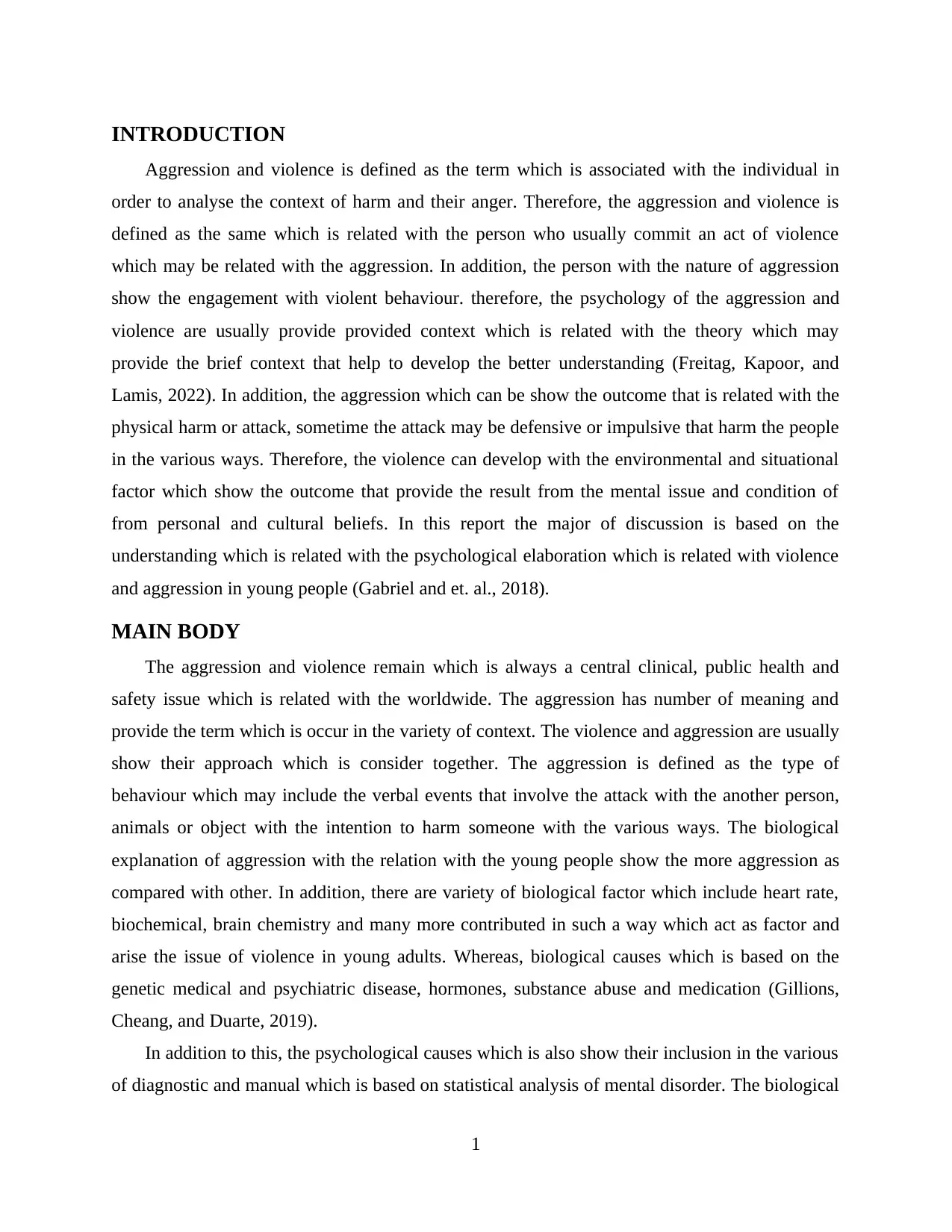
INTRODUCTION
Aggression and violence is defined as the term which is associated with the individual in
order to analyse the context of harm and their anger. Therefore, the aggression and violence is
defined as the same which is related with the person who usually commit an act of violence
which may be related with the aggression. In addition, the person with the nature of aggression
show the engagement with violent behaviour. therefore, the psychology of the aggression and
violence are usually provide provided context which is related with the theory which may
provide the brief context that help to develop the better understanding (Freitag, Kapoor, and
Lamis, 2022). In addition, the aggression which can be show the outcome that is related with the
physical harm or attack, sometime the attack may be defensive or impulsive that harm the people
in the various ways. Therefore, the violence can develop with the environmental and situational
factor which show the outcome that provide the result from the mental issue and condition of
from personal and cultural beliefs. In this report the major of discussion is based on the
understanding which is related with the psychological elaboration which is related with violence
and aggression in young people (Gabriel and et. al., 2018).
MAIN BODY
The aggression and violence remain which is always a central clinical, public health and
safety issue which is related with the worldwide. The aggression has number of meaning and
provide the term which is occur in the variety of context. The violence and aggression are usually
show their approach which is consider together. The aggression is defined as the type of
behaviour which may include the verbal events that involve the attack with the another person,
animals or object with the intention to harm someone with the various ways. The biological
explanation of aggression with the relation with the young people show the more aggression as
compared with other. In addition, there are variety of biological factor which include heart rate,
biochemical, brain chemistry and many more contributed in such a way which act as factor and
arise the issue of violence in young adults. Whereas, biological causes which is based on the
genetic medical and psychiatric disease, hormones, substance abuse and medication (Gillions,
Cheang, and Duarte, 2019).
In addition to this, the psychological causes which is also show their inclusion in the various
of diagnostic and manual which is based on statistical analysis of mental disorder. The biological
1
Aggression and violence is defined as the term which is associated with the individual in
order to analyse the context of harm and their anger. Therefore, the aggression and violence is
defined as the same which is related with the person who usually commit an act of violence
which may be related with the aggression. In addition, the person with the nature of aggression
show the engagement with violent behaviour. therefore, the psychology of the aggression and
violence are usually provide provided context which is related with the theory which may
provide the brief context that help to develop the better understanding (Freitag, Kapoor, and
Lamis, 2022). In addition, the aggression which can be show the outcome that is related with the
physical harm or attack, sometime the attack may be defensive or impulsive that harm the people
in the various ways. Therefore, the violence can develop with the environmental and situational
factor which show the outcome that provide the result from the mental issue and condition of
from personal and cultural beliefs. In this report the major of discussion is based on the
understanding which is related with the psychological elaboration which is related with violence
and aggression in young people (Gabriel and et. al., 2018).
MAIN BODY
The aggression and violence remain which is always a central clinical, public health and
safety issue which is related with the worldwide. The aggression has number of meaning and
provide the term which is occur in the variety of context. The violence and aggression are usually
show their approach which is consider together. The aggression is defined as the type of
behaviour which may include the verbal events that involve the attack with the another person,
animals or object with the intention to harm someone with the various ways. The biological
explanation of aggression with the relation with the young people show the more aggression as
compared with other. In addition, there are variety of biological factor which include heart rate,
biochemical, brain chemistry and many more contributed in such a way which act as factor and
arise the issue of violence in young adults. Whereas, biological causes which is based on the
genetic medical and psychiatric disease, hormones, substance abuse and medication (Gillions,
Cheang, and Duarte, 2019).
In addition to this, the psychological causes which is also show their inclusion in the various
of diagnostic and manual which is based on statistical analysis of mental disorder. The biological
1
⊘ This is a preview!⊘
Do you want full access?
Subscribe today to unlock all pages.

Trusted by 1+ million students worldwide
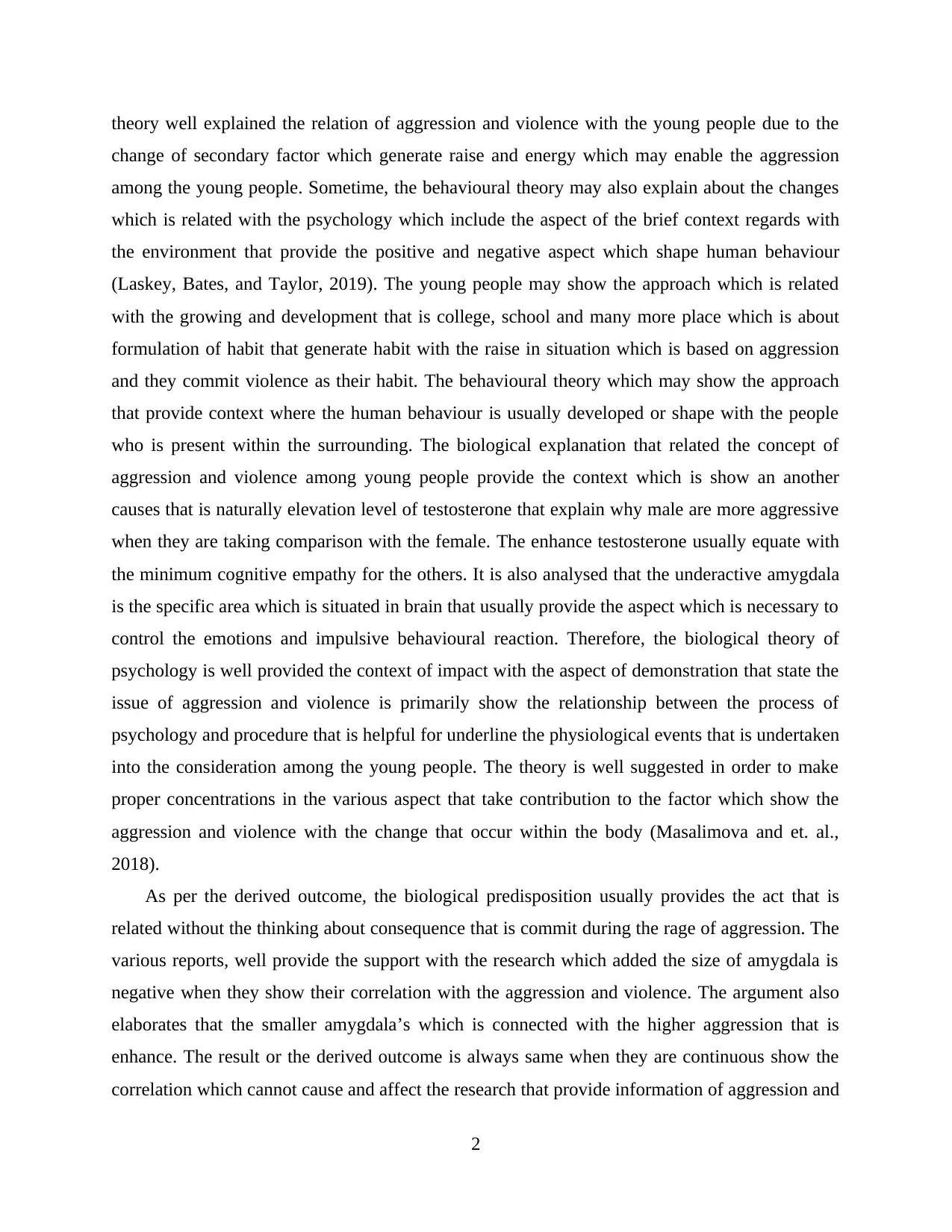
theory well explained the relation of aggression and violence with the young people due to the
change of secondary factor which generate raise and energy which may enable the aggression
among the young people. Sometime, the behavioural theory may also explain about the changes
which is related with the psychology which include the aspect of the brief context regards with
the environment that provide the positive and negative aspect which shape human behaviour
(Laskey, Bates, and Taylor, 2019). The young people may show the approach which is related
with the growing and development that is college, school and many more place which is about
formulation of habit that generate habit with the raise in situation which is based on aggression
and they commit violence as their habit. The behavioural theory which may show the approach
that provide context where the human behaviour is usually developed or shape with the people
who is present within the surrounding. The biological explanation that related the concept of
aggression and violence among young people provide the context which is show an another
causes that is naturally elevation level of testosterone that explain why male are more aggressive
when they are taking comparison with the female. The enhance testosterone usually equate with
the minimum cognitive empathy for the others. It is also analysed that the underactive amygdala
is the specific area which is situated in brain that usually provide the aspect which is necessary to
control the emotions and impulsive behavioural reaction. Therefore, the biological theory of
psychology is well provided the context of impact with the aspect of demonstration that state the
issue of aggression and violence is primarily show the relationship between the process of
psychology and procedure that is helpful for underline the physiological events that is undertaken
into the consideration among the young people. The theory is well suggested in order to make
proper concentrations in the various aspect that take contribution to the factor which show the
aggression and violence with the change that occur within the body (Masalimova and et. al.,
2018).
As per the derived outcome, the biological predisposition usually provides the act that is
related without the thinking about consequence that is commit during the rage of aggression. The
various reports, well provide the support with the research which added the size of amygdala is
negative when they show their correlation with the aggression and violence. The argument also
elaborates that the smaller amygdala’s which is connected with the higher aggression that is
enhance. The result or the derived outcome is always same when they are continuous show the
correlation which cannot cause and affect the research that provide information of aggression and
2
change of secondary factor which generate raise and energy which may enable the aggression
among the young people. Sometime, the behavioural theory may also explain about the changes
which is related with the psychology which include the aspect of the brief context regards with
the environment that provide the positive and negative aspect which shape human behaviour
(Laskey, Bates, and Taylor, 2019). The young people may show the approach which is related
with the growing and development that is college, school and many more place which is about
formulation of habit that generate habit with the raise in situation which is based on aggression
and they commit violence as their habit. The behavioural theory which may show the approach
that provide context where the human behaviour is usually developed or shape with the people
who is present within the surrounding. The biological explanation that related the concept of
aggression and violence among young people provide the context which is show an another
causes that is naturally elevation level of testosterone that explain why male are more aggressive
when they are taking comparison with the female. The enhance testosterone usually equate with
the minimum cognitive empathy for the others. It is also analysed that the underactive amygdala
is the specific area which is situated in brain that usually provide the aspect which is necessary to
control the emotions and impulsive behavioural reaction. Therefore, the biological theory of
psychology is well provided the context of impact with the aspect of demonstration that state the
issue of aggression and violence is primarily show the relationship between the process of
psychology and procedure that is helpful for underline the physiological events that is undertaken
into the consideration among the young people. The theory is well suggested in order to make
proper concentrations in the various aspect that take contribution to the factor which show the
aggression and violence with the change that occur within the body (Masalimova and et. al.,
2018).
As per the derived outcome, the biological predisposition usually provides the act that is
related without the thinking about consequence that is commit during the rage of aggression. The
various reports, well provide the support with the research which added the size of amygdala is
negative when they show their correlation with the aggression and violence. The argument also
elaborates that the smaller amygdala’s which is connected with the higher aggression that is
enhance. The result or the derived outcome is always same when they are continuous show the
correlation which cannot cause and affect the research that provide information of aggression and
2
Paraphrase This Document
Need a fresh take? Get an instant paraphrase of this document with our AI Paraphraser
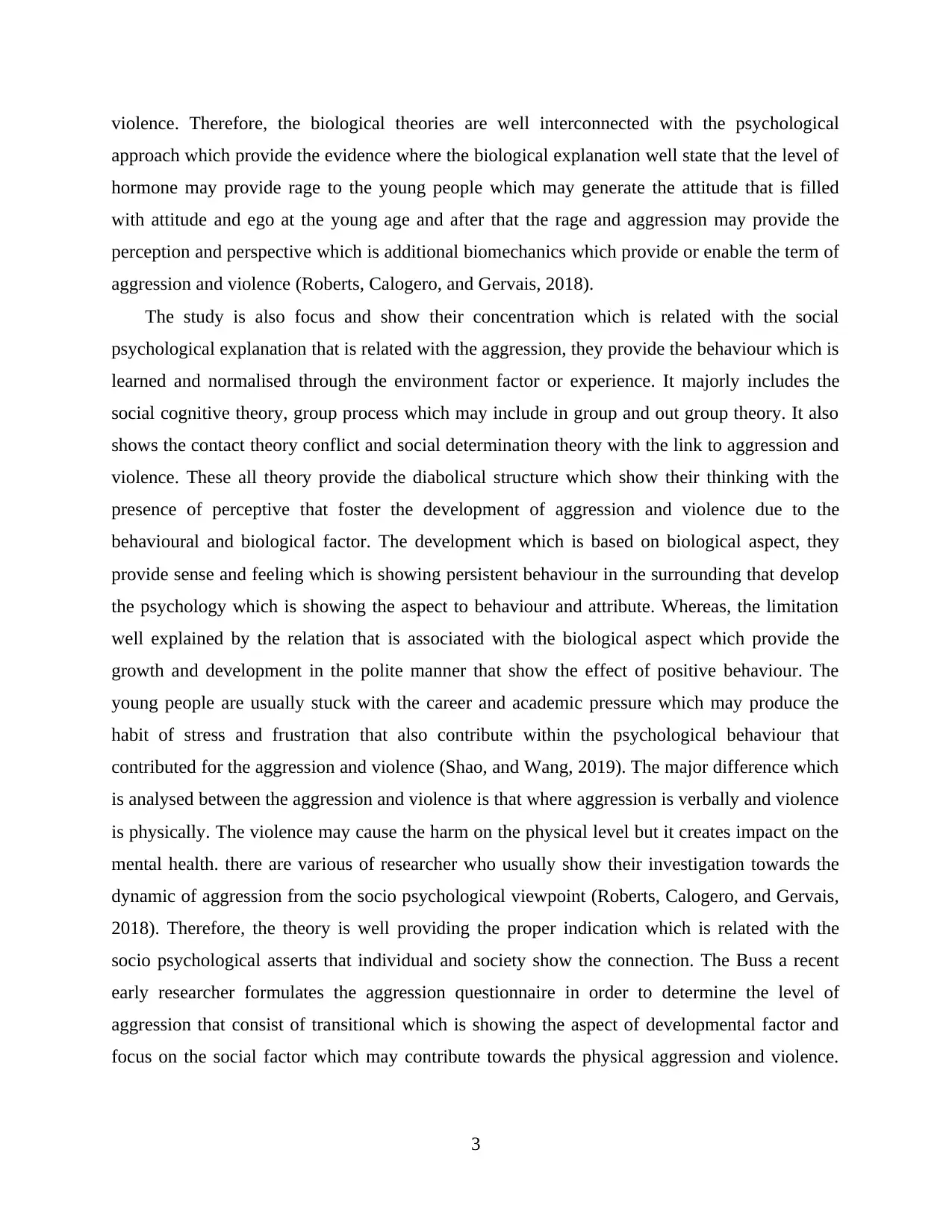
violence. Therefore, the biological theories are well interconnected with the psychological
approach which provide the evidence where the biological explanation well state that the level of
hormone may provide rage to the young people which may generate the attitude that is filled
with attitude and ego at the young age and after that the rage and aggression may provide the
perception and perspective which is additional biomechanics which provide or enable the term of
aggression and violence (Roberts, Calogero, and Gervais, 2018).
The study is also focus and show their concentration which is related with the social
psychological explanation that is related with the aggression, they provide the behaviour which is
learned and normalised through the environment factor or experience. It majorly includes the
social cognitive theory, group process which may include in group and out group theory. It also
shows the contact theory conflict and social determination theory with the link to aggression and
violence. These all theory provide the diabolical structure which show their thinking with the
presence of perceptive that foster the development of aggression and violence due to the
behavioural and biological factor. The development which is based on biological aspect, they
provide sense and feeling which is showing persistent behaviour in the surrounding that develop
the psychology which is showing the aspect to behaviour and attribute. Whereas, the limitation
well explained by the relation that is associated with the biological aspect which provide the
growth and development in the polite manner that show the effect of positive behaviour. The
young people are usually stuck with the career and academic pressure which may produce the
habit of stress and frustration that also contribute within the psychological behaviour that
contributed for the aggression and violence (Shao, and Wang, 2019). The major difference which
is analysed between the aggression and violence is that where aggression is verbally and violence
is physically. The violence may cause the harm on the physical level but it creates impact on the
mental health. there are various of researcher who usually show their investigation towards the
dynamic of aggression from the socio psychological viewpoint (Roberts, Calogero, and Gervais,
2018). Therefore, the theory is well providing the proper indication which is related with the
socio psychological asserts that individual and society show the connection. The Buss a recent
early researcher formulates the aggression questionnaire in order to determine the level of
aggression that consist of transitional which is showing the aspect of developmental factor and
focus on the social factor which may contribute towards the physical aggression and violence.
3
approach which provide the evidence where the biological explanation well state that the level of
hormone may provide rage to the young people which may generate the attitude that is filled
with attitude and ego at the young age and after that the rage and aggression may provide the
perception and perspective which is additional biomechanics which provide or enable the term of
aggression and violence (Roberts, Calogero, and Gervais, 2018).
The study is also focus and show their concentration which is related with the social
psychological explanation that is related with the aggression, they provide the behaviour which is
learned and normalised through the environment factor or experience. It majorly includes the
social cognitive theory, group process which may include in group and out group theory. It also
shows the contact theory conflict and social determination theory with the link to aggression and
violence. These all theory provide the diabolical structure which show their thinking with the
presence of perceptive that foster the development of aggression and violence due to the
behavioural and biological factor. The development which is based on biological aspect, they
provide sense and feeling which is showing persistent behaviour in the surrounding that develop
the psychology which is showing the aspect to behaviour and attribute. Whereas, the limitation
well explained by the relation that is associated with the biological aspect which provide the
growth and development in the polite manner that show the effect of positive behaviour. The
young people are usually stuck with the career and academic pressure which may produce the
habit of stress and frustration that also contribute within the psychological behaviour that
contributed for the aggression and violence (Shao, and Wang, 2019). The major difference which
is analysed between the aggression and violence is that where aggression is verbally and violence
is physically. The violence may cause the harm on the physical level but it creates impact on the
mental health. there are various of researcher who usually show their investigation towards the
dynamic of aggression from the socio psychological viewpoint (Roberts, Calogero, and Gervais,
2018). Therefore, the theory is well providing the proper indication which is related with the
socio psychological asserts that individual and society show the connection. The Buss a recent
early researcher formulates the aggression questionnaire in order to determine the level of
aggression that consist of transitional which is showing the aspect of developmental factor and
focus on the social factor which may contribute towards the physical aggression and violence.
3
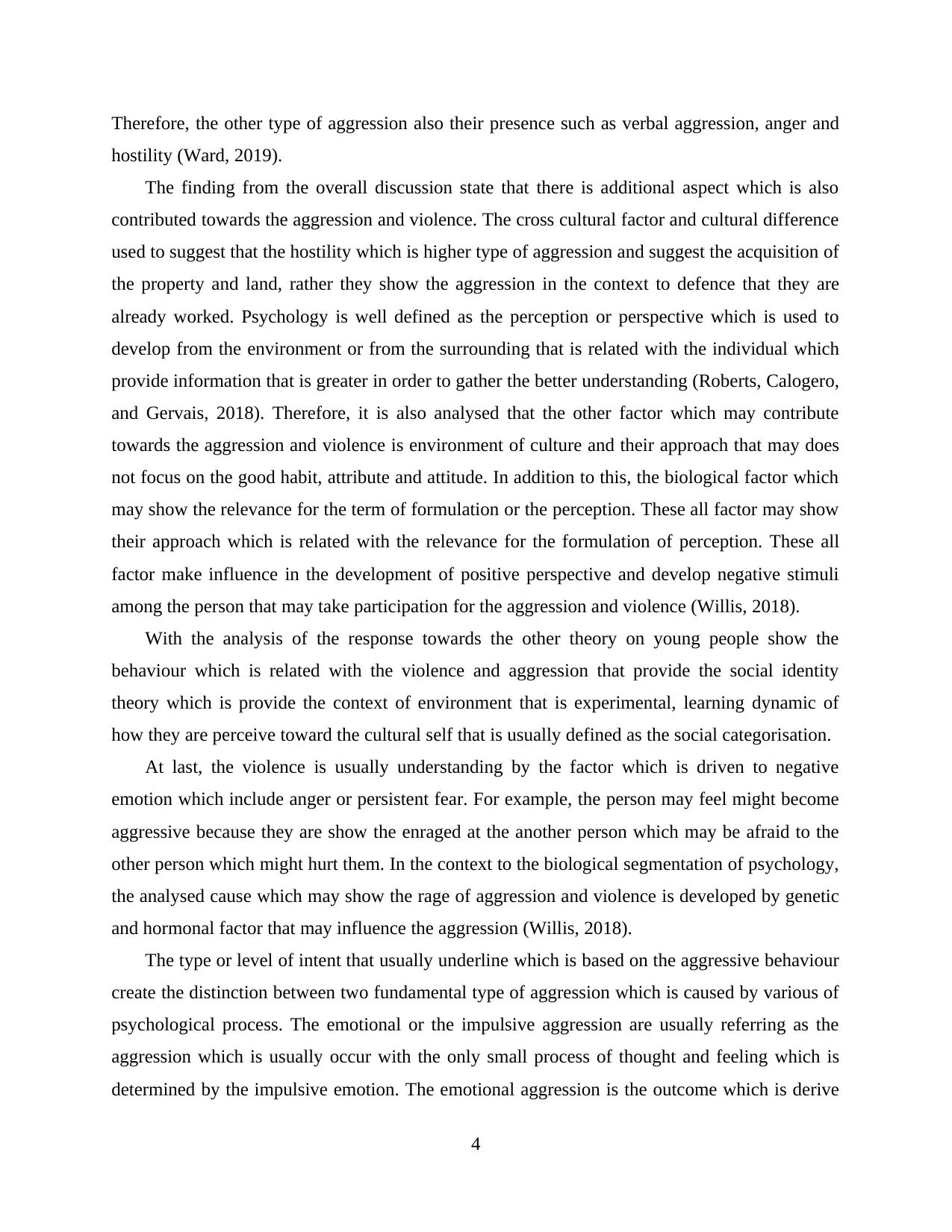
Therefore, the other type of aggression also their presence such as verbal aggression, anger and
hostility (Ward, 2019).
The finding from the overall discussion state that there is additional aspect which is also
contributed towards the aggression and violence. The cross cultural factor and cultural difference
used to suggest that the hostility which is higher type of aggression and suggest the acquisition of
the property and land, rather they show the aggression in the context to defence that they are
already worked. Psychology is well defined as the perception or perspective which is used to
develop from the environment or from the surrounding that is related with the individual which
provide information that is greater in order to gather the better understanding (Roberts, Calogero,
and Gervais, 2018). Therefore, it is also analysed that the other factor which may contribute
towards the aggression and violence is environment of culture and their approach that may does
not focus on the good habit, attribute and attitude. In addition to this, the biological factor which
may show the relevance for the term of formulation or the perception. These all factor may show
their approach which is related with the relevance for the formulation of perception. These all
factor make influence in the development of positive perspective and develop negative stimuli
among the person that may take participation for the aggression and violence (Willis, 2018).
With the analysis of the response towards the other theory on young people show the
behaviour which is related with the violence and aggression that provide the social identity
theory which is provide the context of environment that is experimental, learning dynamic of
how they are perceive toward the cultural self that is usually defined as the social categorisation.
At last, the violence is usually understanding by the factor which is driven to negative
emotion which include anger or persistent fear. For example, the person may feel might become
aggressive because they are show the enraged at the another person which may be afraid to the
other person which might hurt them. In the context to the biological segmentation of psychology,
the analysed cause which may show the rage of aggression and violence is developed by genetic
and hormonal factor that may influence the aggression (Willis, 2018).
The type or level of intent that usually underline which is based on the aggressive behaviour
create the distinction between two fundamental type of aggression which is caused by various of
psychological process. The emotional or the impulsive aggression are usually referring as the
aggression which is usually occur with the only small process of thought and feeling which is
determined by the impulsive emotion. The emotional aggression is the outcome which is derive
4
hostility (Ward, 2019).
The finding from the overall discussion state that there is additional aspect which is also
contributed towards the aggression and violence. The cross cultural factor and cultural difference
used to suggest that the hostility which is higher type of aggression and suggest the acquisition of
the property and land, rather they show the aggression in the context to defence that they are
already worked. Psychology is well defined as the perception or perspective which is used to
develop from the environment or from the surrounding that is related with the individual which
provide information that is greater in order to gather the better understanding (Roberts, Calogero,
and Gervais, 2018). Therefore, it is also analysed that the other factor which may contribute
towards the aggression and violence is environment of culture and their approach that may does
not focus on the good habit, attribute and attitude. In addition to this, the biological factor which
may show the relevance for the term of formulation or the perception. These all factor may show
their approach which is related with the relevance for the formulation of perception. These all
factor make influence in the development of positive perspective and develop negative stimuli
among the person that may take participation for the aggression and violence (Willis, 2018).
With the analysis of the response towards the other theory on young people show the
behaviour which is related with the violence and aggression that provide the social identity
theory which is provide the context of environment that is experimental, learning dynamic of
how they are perceive toward the cultural self that is usually defined as the social categorisation.
At last, the violence is usually understanding by the factor which is driven to negative
emotion which include anger or persistent fear. For example, the person may feel might become
aggressive because they are show the enraged at the another person which may be afraid to the
other person which might hurt them. In the context to the biological segmentation of psychology,
the analysed cause which may show the rage of aggression and violence is developed by genetic
and hormonal factor that may influence the aggression (Willis, 2018).
The type or level of intent that usually underline which is based on the aggressive behaviour
create the distinction between two fundamental type of aggression which is caused by various of
psychological process. The emotional or the impulsive aggression are usually referring as the
aggression which is usually occur with the only small process of thought and feeling which is
determined by the impulsive emotion. The emotional aggression is the outcome which is derive
4
⊘ This is a preview!⊘
Do you want full access?
Subscribe today to unlock all pages.

Trusted by 1+ million students worldwide
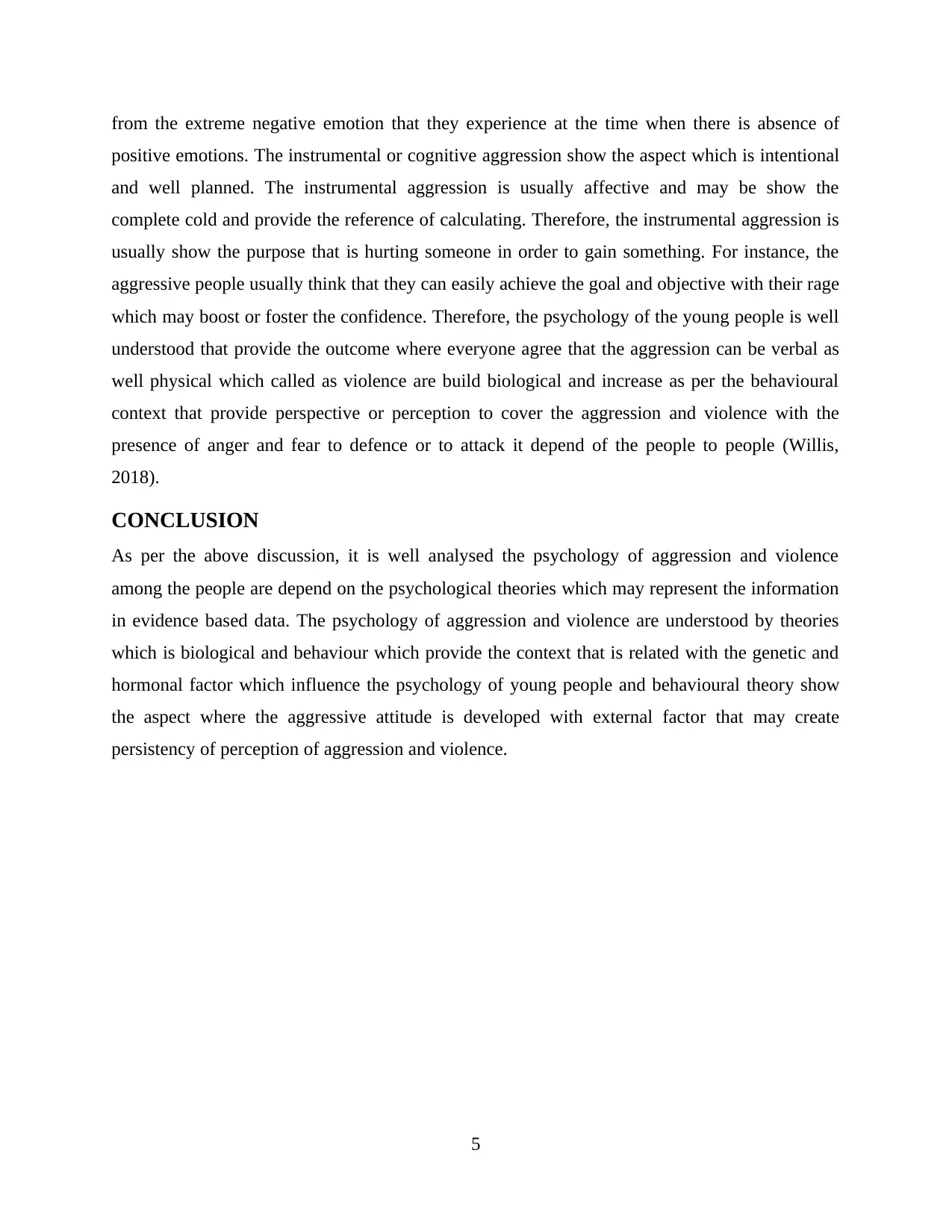
from the extreme negative emotion that they experience at the time when there is absence of
positive emotions. The instrumental or cognitive aggression show the aspect which is intentional
and well planned. The instrumental aggression is usually affective and may be show the
complete cold and provide the reference of calculating. Therefore, the instrumental aggression is
usually show the purpose that is hurting someone in order to gain something. For instance, the
aggressive people usually think that they can easily achieve the goal and objective with their rage
which may boost or foster the confidence. Therefore, the psychology of the young people is well
understood that provide the outcome where everyone agree that the aggression can be verbal as
well physical which called as violence are build biological and increase as per the behavioural
context that provide perspective or perception to cover the aggression and violence with the
presence of anger and fear to defence or to attack it depend of the people to people (Willis,
2018).
CONCLUSION
As per the above discussion, it is well analysed the psychology of aggression and violence
among the people are depend on the psychological theories which may represent the information
in evidence based data. The psychology of aggression and violence are understood by theories
which is biological and behaviour which provide the context that is related with the genetic and
hormonal factor which influence the psychology of young people and behavioural theory show
the aspect where the aggressive attitude is developed with external factor that may create
persistency of perception of aggression and violence.
5
positive emotions. The instrumental or cognitive aggression show the aspect which is intentional
and well planned. The instrumental aggression is usually affective and may be show the
complete cold and provide the reference of calculating. Therefore, the instrumental aggression is
usually show the purpose that is hurting someone in order to gain something. For instance, the
aggressive people usually think that they can easily achieve the goal and objective with their rage
which may boost or foster the confidence. Therefore, the psychology of the young people is well
understood that provide the outcome where everyone agree that the aggression can be verbal as
well physical which called as violence are build biological and increase as per the behavioural
context that provide perspective or perception to cover the aggression and violence with the
presence of anger and fear to defence or to attack it depend of the people to people (Willis,
2018).
CONCLUSION
As per the above discussion, it is well analysed the psychology of aggression and violence
among the people are depend on the psychological theories which may represent the information
in evidence based data. The psychology of aggression and violence are understood by theories
which is biological and behaviour which provide the context that is related with the genetic and
hormonal factor which influence the psychology of young people and behavioural theory show
the aspect where the aggressive attitude is developed with external factor that may create
persistency of perception of aggression and violence.
5
Paraphrase This Document
Need a fresh take? Get an instant paraphrase of this document with our AI Paraphraser
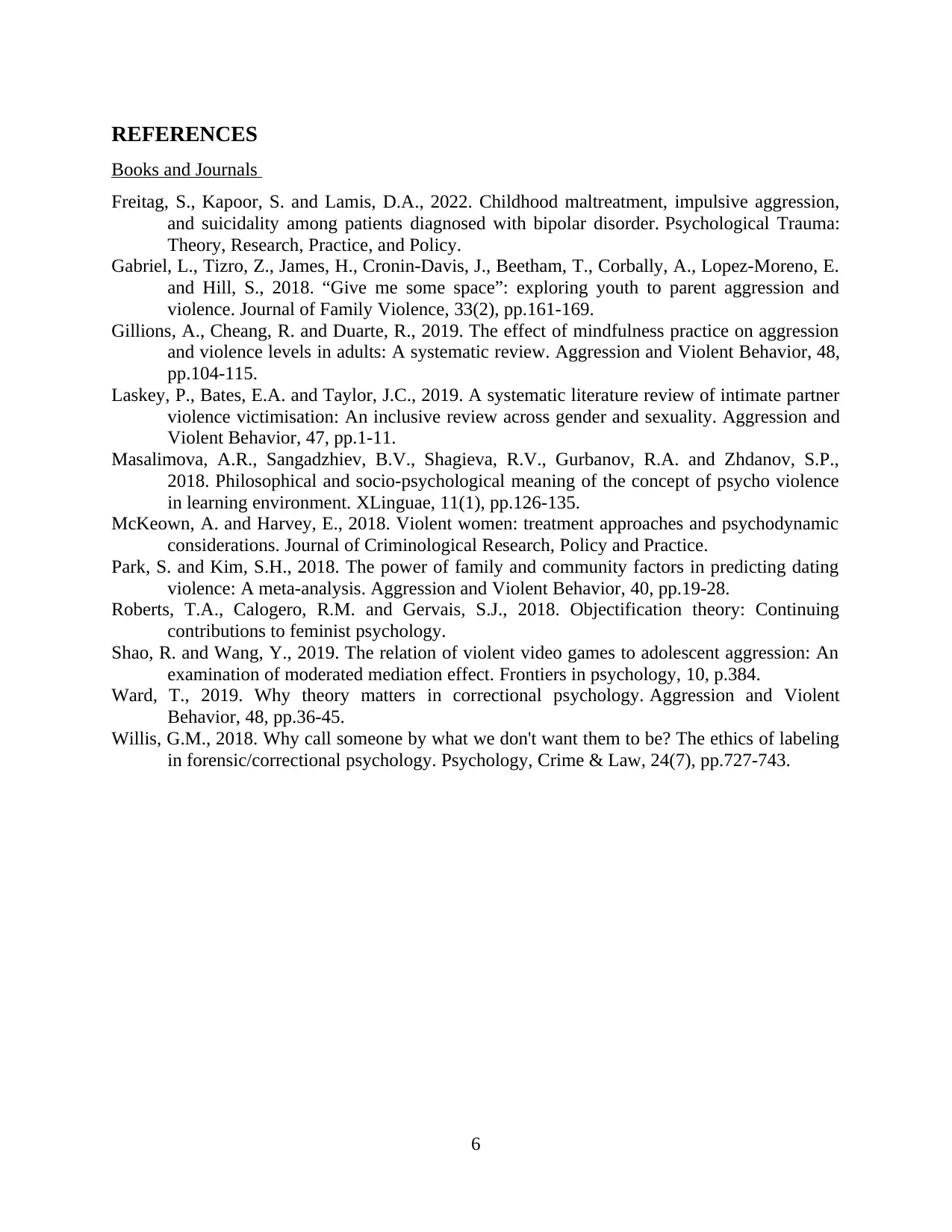
REFERENCES
Books and Journals
Freitag, S., Kapoor, S. and Lamis, D.A., 2022. Childhood maltreatment, impulsive aggression,
and suicidality among patients diagnosed with bipolar disorder. Psychological Trauma:
Theory, Research, Practice, and Policy.
Gabriel, L., Tizro, Z., James, H., Cronin-Davis, J., Beetham, T., Corbally, A., Lopez-Moreno, E.
and Hill, S., 2018. “Give me some space”: exploring youth to parent aggression and
violence. Journal of Family Violence, 33(2), pp.161-169.
Gillions, A., Cheang, R. and Duarte, R., 2019. The effect of mindfulness practice on aggression
and violence levels in adults: A systematic review. Aggression and Violent Behavior, 48,
pp.104-115.
Laskey, P., Bates, E.A. and Taylor, J.C., 2019. A systematic literature review of intimate partner
violence victimisation: An inclusive review across gender and sexuality. Aggression and
Violent Behavior, 47, pp.1-11.
Masalimova, A.R., Sangadzhiev, B.V., Shagieva, R.V., Gurbanov, R.A. and Zhdanov, S.P.,
2018. Philosophical and socio-psychological meaning of the concept of psycho violence
in learning environment. XLinguae, 11(1), pp.126-135.
McKeown, A. and Harvey, E., 2018. Violent women: treatment approaches and psychodynamic
considerations. Journal of Criminological Research, Policy and Practice.
Park, S. and Kim, S.H., 2018. The power of family and community factors in predicting dating
violence: A meta-analysis. Aggression and Violent Behavior, 40, pp.19-28.
Roberts, T.A., Calogero, R.M. and Gervais, S.J., 2018. Objectification theory: Continuing
contributions to feminist psychology.
Shao, R. and Wang, Y., 2019. The relation of violent video games to adolescent aggression: An
examination of moderated mediation effect. Frontiers in psychology, 10, p.384.
Ward, T., 2019. Why theory matters in correctional psychology. Aggression and Violent
Behavior, 48, pp.36-45.
Willis, G.M., 2018. Why call someone by what we don't want them to be? The ethics of labeling
in forensic/correctional psychology. Psychology, Crime & Law, 24(7), pp.727-743.
6
Books and Journals
Freitag, S., Kapoor, S. and Lamis, D.A., 2022. Childhood maltreatment, impulsive aggression,
and suicidality among patients diagnosed with bipolar disorder. Psychological Trauma:
Theory, Research, Practice, and Policy.
Gabriel, L., Tizro, Z., James, H., Cronin-Davis, J., Beetham, T., Corbally, A., Lopez-Moreno, E.
and Hill, S., 2018. “Give me some space”: exploring youth to parent aggression and
violence. Journal of Family Violence, 33(2), pp.161-169.
Gillions, A., Cheang, R. and Duarte, R., 2019. The effect of mindfulness practice on aggression
and violence levels in adults: A systematic review. Aggression and Violent Behavior, 48,
pp.104-115.
Laskey, P., Bates, E.A. and Taylor, J.C., 2019. A systematic literature review of intimate partner
violence victimisation: An inclusive review across gender and sexuality. Aggression and
Violent Behavior, 47, pp.1-11.
Masalimova, A.R., Sangadzhiev, B.V., Shagieva, R.V., Gurbanov, R.A. and Zhdanov, S.P.,
2018. Philosophical and socio-psychological meaning of the concept of psycho violence
in learning environment. XLinguae, 11(1), pp.126-135.
McKeown, A. and Harvey, E., 2018. Violent women: treatment approaches and psychodynamic
considerations. Journal of Criminological Research, Policy and Practice.
Park, S. and Kim, S.H., 2018. The power of family and community factors in predicting dating
violence: A meta-analysis. Aggression and Violent Behavior, 40, pp.19-28.
Roberts, T.A., Calogero, R.M. and Gervais, S.J., 2018. Objectification theory: Continuing
contributions to feminist psychology.
Shao, R. and Wang, Y., 2019. The relation of violent video games to adolescent aggression: An
examination of moderated mediation effect. Frontiers in psychology, 10, p.384.
Ward, T., 2019. Why theory matters in correctional psychology. Aggression and Violent
Behavior, 48, pp.36-45.
Willis, G.M., 2018. Why call someone by what we don't want them to be? The ethics of labeling
in forensic/correctional psychology. Psychology, Crime & Law, 24(7), pp.727-743.
6
1 out of 8
Related Documents
Your All-in-One AI-Powered Toolkit for Academic Success.
+13062052269
info@desklib.com
Available 24*7 on WhatsApp / Email
![[object Object]](/_next/static/media/star-bottom.7253800d.svg)
Unlock your academic potential
Copyright © 2020–2025 A2Z Services. All Rights Reserved. Developed and managed by ZUCOL.




